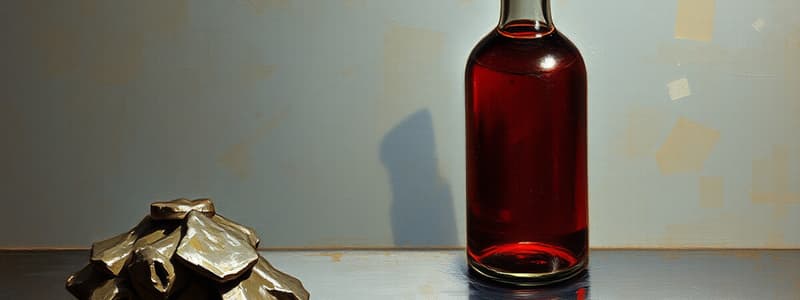Podcast
Questions and Answers
Solutions are characterized as which type of mixture made up of very small particles?
Solutions are characterized as which type of mixture made up of very small particles?
- Colloidal
- Heterogeneous
- Suspension
- Homogeneous (correct)
What type of solution is 14-carat gold classified as?
What type of solution is 14-carat gold classified as?
- Liquid solution
- Solid solution (correct)
- Suspension
- Gaseous solution
Which of the following methods can increase the rate of dissolving a solid in water?
Which of the following methods can increase the rate of dissolving a solid in water?
- Increasing the size of the solid particles
- Increasing the temperature of the water (correct)
- Decreasing the surface area of the solid
- Adding more solvent to the solution
What is an example of a gaseous solution?
What is an example of a gaseous solution?
What term describes liquids that can dissolve in each other?
What term describes liquids that can dissolve in each other?
Which statement about solutions and suspensions is true?
Which statement about solutions and suspensions is true?
What happens to smoke particles after some time in the air?
What happens to smoke particles after some time in the air?
In a solution, which substance is the solvent?
In a solution, which substance is the solvent?
What term describes a solution that contains both components in the same phase?
What term describes a solution that contains both components in the same phase?
What is the main reason why solutions are considered homogeneous mixtures?
What is the main reason why solutions are considered homogeneous mixtures?
Why can light beams from car headlights be seen in fog?
Why can light beams from car headlights be seen in fog?
If a solution is described as being made mainly of oxygen and nitrogen, what type of solution is it considered?
If a solution is described as being made mainly of oxygen and nitrogen, what type of solution is it considered?
What is the definition of immiscible liquids?
What is the definition of immiscible liquids?
If 15 grams of iodine is dissolved in 1000 mL of alcohol, which substance is the solute?
If 15 grams of iodine is dissolved in 1000 mL of alcohol, which substance is the solute?
Which property distinguishes solutions from suspensions?
Which property distinguishes solutions from suspensions?
How can the rate of a solid dissolving in water be increased?
How can the rate of a solid dissolving in water be increased?
Flashcards are hidden until you start studying
Study Notes
Classification of Solutions
- Solutions are classified as homogeneous mixtures instead of heterogeneous mixtures.
- They consist of very small particles that can be molecules, atoms, or ions.
Phases of Solutions
- Solutions exist in a single phase, regardless of the original phases of their components.
Gold Composition
- Pure gold is 24 carat; 14-carat gold contains 14 parts gold and 10 parts other metals, classified as an alloy, a type of homogeneous solution.
Gaseous Solutions
- An example of a gaseous solution is air, primarily composed of oxygen and nitrogen when dry.
Common Solutions
- The most common solutions encountered are liquid solutions.
Definitions
- Miscible: Liquids that will dissolve in each other.
- Immiscible: Liquids that do not dissolve in each other.
Tyndall Effect
- The Tyndall effect explains why light beams from car headlights are visible in fog.
Increasing Rate of Solution
- To increase the rate of solution of a solid in water, crush the particles of the solid.
Solute and Solvent
- In a solution of 15 grams of iodine dissolved in 1000 mL of alcohol, alcohol acts as the solvent, and the solution is classified as a homogeneous solution.
- A substance that dissolves other materials is referred to as a solvent, while the substance being dissolved is the solute.
Solutions vs. Suspensions
- Solutions do not separate upon standing, unlike suspensions which do separate.
- Suspensions can also be separated by filtration.
Smoke Example
- Smoke illustrates a suspension of solid dirt and dust particles in air, which settle over time.
Colloids
- A colloid's particles are intermediate in size between those of a solution and a suspension.
- Emulsions are colloids comprising one liquid dispersed in another liquid, stabilized by an emulsifying agent.
Aqueous Solutions
- An aqueous solution is one in which water is the solvent.
Solute in Brass Alloy
- In brass, the solute is zinc, comprising 25% of the alloy.
Light Behavior in Solutions vs. Suspensions
- Solutions do not scatter light, allowing a beam of light to pass through clearly, unlike suspensions which scatter light.
Conductivity of Solutions
- Substances that conduct electricity when dissolved are termed electrolytes, while those that do not are considered nonelectrolytes.
Classification of Solutions
- Solutions are classified as homogeneous mixtures instead of heterogeneous mixtures.
- They consist of very small particles that can be molecules, atoms, or ions.
Phases of Solutions
- Solutions exist in a single phase, regardless of the original phases of their components.
Gold Composition
- Pure gold is 24 carat; 14-carat gold contains 14 parts gold and 10 parts other metals, classified as an alloy, a type of homogeneous solution.
Gaseous Solutions
- An example of a gaseous solution is air, primarily composed of oxygen and nitrogen when dry.
Common Solutions
- The most common solutions encountered are liquid solutions.
Definitions
- Miscible: Liquids that will dissolve in each other.
- Immiscible: Liquids that do not dissolve in each other.
Tyndall Effect
- The Tyndall effect explains why light beams from car headlights are visible in fog.
Increasing Rate of Solution
- To increase the rate of solution of a solid in water, crush the particles of the solid.
Solute and Solvent
- In a solution of 15 grams of iodine dissolved in 1000 mL of alcohol, alcohol acts as the solvent, and the solution is classified as a homogeneous solution.
- A substance that dissolves other materials is referred to as a solvent, while the substance being dissolved is the solute.
Solutions vs. Suspensions
- Solutions do not separate upon standing, unlike suspensions which do separate.
- Suspensions can also be separated by filtration.
Smoke Example
- Smoke illustrates a suspension of solid dirt and dust particles in air, which settle over time.
Colloids
- A colloid's particles are intermediate in size between those of a solution and a suspension.
- Emulsions are colloids comprising one liquid dispersed in another liquid, stabilized by an emulsifying agent.
Aqueous Solutions
- An aqueous solution is one in which water is the solvent.
Solute in Brass Alloy
- In brass, the solute is zinc, comprising 25% of the alloy.
Light Behavior in Solutions vs. Suspensions
- Solutions do not scatter light, allowing a beam of light to pass through clearly, unlike suspensions which scatter light.
Conductivity of Solutions
- Substances that conduct electricity when dissolved are termed electrolytes, while those that do not are considered nonelectrolytes.
Studying That Suits You
Use AI to generate personalized quizzes and flashcards to suit your learning preferences.





